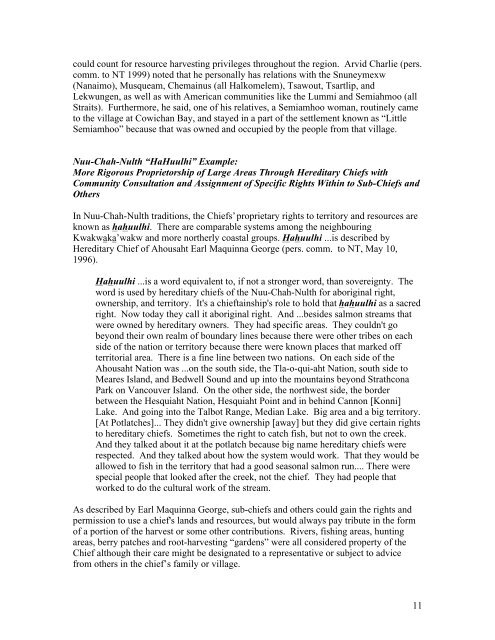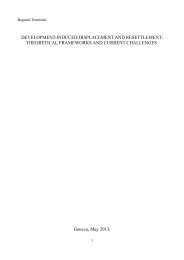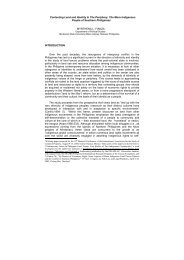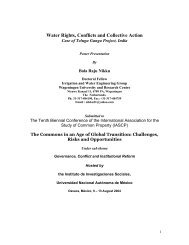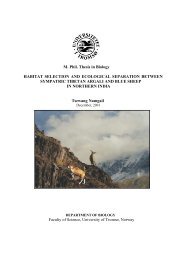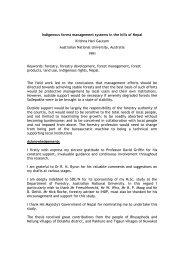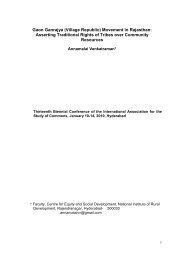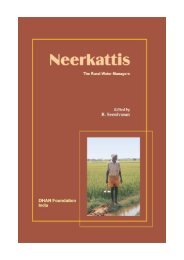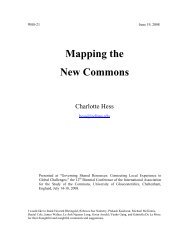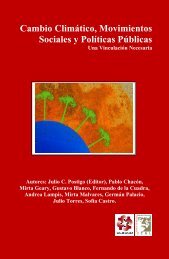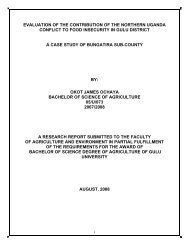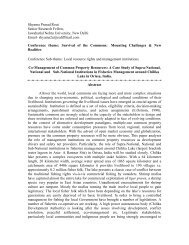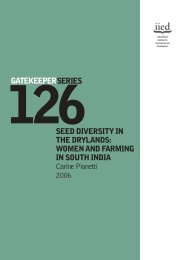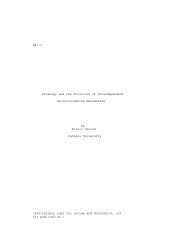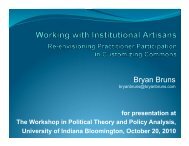ask permission to use <strong>the</strong> traps from those who built <strong>the</strong>m. Gun<strong>the</strong>r (1927:199) reportedthat Clallam salmon traps were owned by "<strong>the</strong> chief of <strong>the</strong> village, who tends it at night,leaving it during <strong>the</strong> day-time for his poor relatives who have not traps of <strong>the</strong>ir own."Deer-nets and deer-pits were likewise owned property. <strong>The</strong>ir operation was directed by<strong>the</strong> owner, but sites where <strong>the</strong>y were situated were not necessarily owned. As notedpreviously, aerial duck-nets were owned by families, as were <strong>the</strong> poles used to erect <strong>the</strong>m,but <strong>the</strong> sites where <strong>the</strong>y were erected were used by several tribes in common (Suttles1951:72). Suttles (1990:459), however, suggests that such sites were formerlyindividually owned.<strong>The</strong>se ownership traditions were closely intertwined with seasonal rounds, <strong>the</strong>movements of people over <strong>the</strong> harvest season from one site to ano<strong>the</strong>r where <strong>the</strong>y hadcustomary or culturally recognized rights. Jenness (1934-1935: 70) reported, "Wintervillage sites were situated within an area where people obtained large portions of <strong>the</strong>irfood and materials, and which <strong>the</strong>y identified using names in <strong>the</strong>ir own language. Agroup’s territory is commonly identified by applying <strong>the</strong> suffix /-ulh/ meaning ’of orbelonging to’... One’s territory is also <strong>the</strong> landscape imbued with oral tradition...Ownership was expressed individually as <strong>the</strong> right to use resources in a multitude ofareas, and was independent of proprietary feelings for one's tribal territory.”<strong>The</strong> East Saanich [Tsawout], <strong>the</strong> Songish [Legwungen] and those near Chemainusfollowed practically <strong>the</strong> same routine as <strong>the</strong> West Saanich; <strong>the</strong>y all left <strong>the</strong>ir main villagesin <strong>the</strong> middle of summer and netted sockeye and humpbacked salmon on <strong>the</strong> mainland,off <strong>the</strong> mouth of <strong>the</strong> Fraser River, as reported by Jenness (1934-1935:18). Also, "If <strong>the</strong>wea<strong>the</strong>r was warm, many of <strong>the</strong> [Saanich] people left <strong>the</strong> village and camped near <strong>the</strong>ircamas grounds on San Juan Island, using for shelter ei<strong>the</strong>r a few boards taken from <strong>the</strong>irhouse, or rush huts (Jenness 1934-1935: 7). <strong>The</strong> Suneymexw (“Solachwan”) people of <strong>the</strong>Nanaimo area, according to Jenness (1934-1935: 9), occupied <strong>the</strong>ir village until aboutApril, “when <strong>the</strong>y joined <strong>the</strong> o<strong>the</strong>rs in moving out to False Narrows and Gabriola Islandto fish for cod, grilse and o<strong>the</strong>r species, to hunt seals and seal-lions and to ga<strong>the</strong>r clamsand camas; for every family had its own bed of camas on Gabriola Island.”<strong>The</strong> Cowichan Halkomelem, according to Jenness (1934-1935: 8), had no fishing rightson <strong>the</strong> mainland, but only over <strong>the</strong> waters immediately adjacent to <strong>the</strong>ir shore and aroundMayne and Saltspring Islands. Jenness added that at Point Roberts, on <strong>the</strong> Mainland southof Tsawwassen, where Saanich families went to fish, each family dried its fish, year afteryear, in <strong>the</strong> same spot, and <strong>the</strong>y left <strong>the</strong>ir stone net-sinkers at this location to be used <strong>the</strong>following year. <strong>The</strong>re was a careful distribution of fish with a special counting system(Jenness 1934-1935: 18). Actually, <strong>the</strong>re are o<strong>the</strong>r reports that <strong>the</strong> Cowichan did haverights to harvest sites on <strong>the</strong> Mainland. Arvid Charlie (pers. comm., 1999) stated that <strong>the</strong>people from Cowichan not only had property and resource harvesting sites on <strong>the</strong> GulfIslands, but that <strong>the</strong>y owned an island near Port Moody along <strong>the</strong> Fraser River, and went<strong>the</strong>re specifically to harvest cat-tails. It seems unlikely that <strong>the</strong>y would not have taken thisopportunity to fish as well.In any case, as noted by Kennedy (1993), Jenness (1934-1935), Suttles (1990) and o<strong>the</strong>rs,<strong>the</strong>re was such an extensive network of affinal ties from inter-village and inter-nationmarriages among <strong>the</strong> Central Coast Salish, that most people had relations on whom <strong>the</strong>y10
could count for resource harvesting privileges throughout <strong>the</strong> region. Arvid Charlie (pers.comm. to NT 1999) noted that he personally has relations with <strong>the</strong> Snuneymexw(Nanaimo), Musqueam, Chemainus (all Halkomelem), Tsawout, Tsartlip, andLekwungen, as well as with American communities like <strong>the</strong> Lummi and Semiahmoo (allStraits). Fur<strong>the</strong>rmore, he said, one of his relatives, a Semiamhoo woman, routinely cameto <strong>the</strong> village at Cowichan Bay, and stayed in a part of <strong>the</strong> settlement known as “LittleSemiamhoo” because that was owned and occupied by <strong>the</strong> people from that village.Nuu-Chah-Nulth “HaHuulhi” Example:More Rigorous Proprietorship of Large Areas Through Hereditary Chiefs withCommunity Consultation and Assignment of Specific Rights Within to Sub-Chiefs andO<strong>the</strong>rsIn Nuu-Chah-Nulth traditions, <strong>the</strong> Chiefs’ proprietary rights to territory and resources areknown as hahuulhi. <strong>The</strong>re are comparable systems among <strong>the</strong> neighbouringKwakwaka’wakw and more nor<strong>the</strong>rly coastal groups. Hahuulhi ...is described byHereditary Chief of Ahousaht Earl Maquinna George (pers. comm. to NT, May 10,1996).Hahuulhi ...is a word equivalent to, if not a stronger word, than sovereignty. <strong>The</strong>word is used by hereditary chiefs of <strong>the</strong> Nuu-Chah-Nulth for aboriginal right,ownership, and territory. It's a chieftainship's role to hold that hahuulhi as a sacredright. Now today <strong>the</strong>y call it aboriginal right. And ...besides salmon streams thatwere owned by hereditary owners. <strong>The</strong>y had specific areas. <strong>The</strong>y couldn't gobeyond <strong>the</strong>ir own realm of boundary lines because <strong>the</strong>re were o<strong>the</strong>r tribes on eachside of <strong>the</strong> nation or territory because <strong>the</strong>re were known places that marked offterritorial area. <strong>The</strong>re is a fine line between two nations. On each side of <strong>the</strong>Ahousaht Nation was ...on <strong>the</strong> south side, <strong>the</strong> Tla-o-qui-aht Nation, south side toMeares Island, and Bedwell Sound and up into <strong>the</strong> mountains beyond StrathconaPark on Vancouver Island. On <strong>the</strong> o<strong>the</strong>r side, <strong>the</strong> northwest side, <strong>the</strong> borderbetween <strong>the</strong> Hesquiaht Nation, Hesquiaht Point and in behind Cannon [Konni]Lake. And going into <strong>the</strong> Talbot Range, Median Lake. Big area and a big territory.[At Potlatches]... <strong>The</strong>y didn't give ownership [away] but <strong>the</strong>y did give certain rightsto hereditary chiefs. Sometimes <strong>the</strong> right to catch fish, but not to own <strong>the</strong> creek.And <strong>the</strong>y talked about it at <strong>the</strong> potlatch because big name hereditary chiefs wererespected. And <strong>the</strong>y talked about how <strong>the</strong> system would work. That <strong>the</strong>y would beallowed to fish in <strong>the</strong> territory that had a good seasonal salmon run.... <strong>The</strong>re werespecial people that looked after <strong>the</strong> creek, not <strong>the</strong> chief. <strong>The</strong>y had people thatworked to do <strong>the</strong> cultural work of <strong>the</strong> stream.As described by Earl Maquinna George, sub-chiefs and o<strong>the</strong>rs could gain <strong>the</strong> rights andpermission to use a chief's lands and resources, but would always pay tribute in <strong>the</strong> formof a portion of <strong>the</strong> harvest or some o<strong>the</strong>r contributions. Rivers, fishing areas, huntingareas, berry patches and root-harvesting “gardens” were all considered property of <strong>the</strong>Chief although <strong>the</strong>ir care might be designated to a representative or subject to advicefrom o<strong>the</strong>rs in <strong>the</strong> chief’s family or village.11
- Page 2 and 3: settlement. Notably, the template f
- Page 4 and 5: Indigenous Group(Language Family);R
- Page 6 and 7: Sekani, Dakelh or Carrier,Tsilhqot
- Page 8 and 9: families," and the use by others re
- Page 12 and 13: ... in the case of a salmon stream,
- Page 14 and 15: As well as gardens, patches and sta
- Page 16 and 17: Charles Newcombe (1902: Haida - Ksa
- Page 18 and 19: • Succession:: Territories and si
- Page 20 and 21: The burgeoning field of traditional
- Page 22 and 23: longest time", which became the fou
- Page 24 and 25: Barnett, Homer G. 1955. The Coast S
- Page 26 and 27: Hamori-Torok, Charles. 1990. Haisla
- Page 28 and 29: Richardson, Allan. 1976. The Contro
- Page 30: email to Nives Dolsak and Elinor Os


